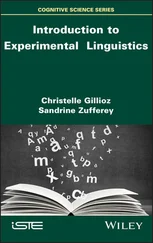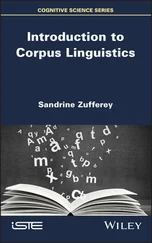2
linguistics
with respect to such data that we test our hypotheses about native speakers’
linguistic cognitive systems. Often, linguists, as native speakers of some language or other, rely on themselves as informants. Linguists (as opposed to psycholinguists, see below) do not conduct controlled experiments on large numbers of subjects under laboratory conditions. This is a major methodological difference between linguists and cognitive psychologists in their study of the human mind, and some critics might see it as making linguistics unscientific or subjective.
However, it is important to point out that the data with which linguists work (supplied by themselves or by other native speakers) usually have such clear properties as to render controlled experimentation pointless. For instance, consider the examples in (5):
(5)
a.
The dog chased the cat
b.
*Cat the dog chased the
A native speaker of English will tell us that (5a) is a possible sentence of English but (5b) is not (the * is conventionally used to indicate this latter judgement). Of course, we could design experiments with large numbers of native speakers to establish the reliability of these claims, but there is no reason to believe that such experiments would be anything other than a colossal waste of time. Native speakers have vast amounts of data readily available to them, and it would be perverse for linguists not to take advantage of this. Notice that above we said that the data supplied by native speakers usually have very clear properties. When this is not the case (and an example will arise in our discussion of psycholinguistics below), we proceed with more caution, trying to understand the source of difficulty.
The logical priority of question (1) should not lead to the conclusion that we must have a complete answer to this question before considering our other
questions. Although question (2) requires some view on the cognitive linguistic system, there is no reason why acquisition studies of small children should not themselves lead to modifications in this view. In such a case, pursuit of question
(2) will be contributing towards answering question (1), and similar possibilities exist for (3) and (4). In practice, many linguists, developmental linguists, psycholinguists and neurolinguists are familiar with each other’s work, and there is a constant interchange of ideas between those working on our four questions.
Our questions foster different approaches to linguistic issues, and in this
introduction we shall first take a preliminary look at these. Having done this, we shall turn to the social perspective mentioned at the outset and offer some initial remarks on how this is pursued.
Linguistics
To begin to answer question (1), Chomsky identifies knowing a language with having a mentally represented grammar. This grammar constitutes the native speaker’s competence in that language, and on this view, the key to
Introduction
3
understanding what it means to know a language is to understand the nature of such a grammar. Competence is contrasted with performance, the perception
and production of speech, the study of which falls under psycholinguistics
(see below). Since this is a fundamental distinction that underlies a great deal of what we shall be discussing, it is worth trying to get a clear grasp of it as early as possible. Consider the situation of a native speaker of English who suffers a blow to the head and, as a consequence, loses the ability to speak, write, read and understand English. In fortunate cases, such a loss of ability can be short-lived, and the ability to use English in the familiar ways reappears quite rapidly. What cognitive functions are impaired during the time when there is no use of language?
Obviously, the ability to use language, i.e. to perform in various ways, is not available through this period, but what about knowledge of English, i.e. linguistic competence? If we suppose that this is lost, then we would expect to see a long period corresponding to the initial acquisition of language as it is regained, rather than the rapid re-emergence which sometimes occurs. It makes more sense to
suppose that knowledge of language remains intact throughout such an episode; the problem is one of accessing this knowledge and putting it to use in speaking, etc. As soon as this problem is overcome, full knowledge of English is available, and the various abilities are rapidly reinstated.
What does a grammar consist of? The traditional view is that a grammar tells us how to combine words to form phrases and sentences. For example, by combining a word like to with a word like Paris we form the phrase to Paris, which can be used as a reply to the question asked by speaker A in the dialogue below:
(6)
speaker a: Where have you been?
speaker b: To Paris.
By combining the phrase to Paris with the word flown we form the larger phrase flown to Paris, which can serve as a reply to the question asked by speaker A in (7): (7)
speaker a: What’s he done?
speaker b: Flown to Paris.
And by combining the phrase flown to Paris with words like has and he, we can form the sentence in (8):
(8)
He has flown to Paris
On this view, a grammar of a language specifies how to combine words to form phrases and sentences, and it seems entirely appropriate to suggest that native speakers of English and of other languages have access to cognitive systems
which somehow specify these possibilities for combination (exercise 1). A very important aspect of this way of looking at things is that it enables us to make sense of how a cognitive system (necessarily finite, since it is represented in a brain) can somehow characterise an infinite set of objects (the phrases and sentences in a natural language). That natural languages are infinite in this sense is easy to see by considering examples such as those in (9):
4
linguistics
(9)
a.
Smith believes that the earth is flat
b.
Brown believes that Smith believes that the earth is flat
c.
Smith believes that Brown believes that Smith believes that the earth is flat d.
Brown believes that Smith believes that Brown believes that Smith believes
that the earth is flat
A native speaker of English will recognise that such a sequence of sentences could be indefinitely extended, and the same point can be made in connection with a variety of other constructions in English and other languages (exercise 2).
But the infinite nature of the set of English sentences, exemplified by those in (9), does not entail that the principles of combination used in constructing these sentences are also infinite; and it is these principles which form part of a grammar.
The view we have introduced above implies that a grammar contains two
components: (i) a lexicon (or dictionary), which lists all the words found in the language, and (ii) a syntactic component, which specifies how to combine words together to form phrases and sentences. Each lexical entry (i.e. each item listed in the lexicon) will tell us about the linguistic properties of a word. For example, the entry for the word man will specify its phonological (= sound) properties (namely that it is pronounced /man/ – for the significance of the slashes, see section 5), its grammatical properties (e.g. that it can function as a noun and that when it does, it has the irregular plural form men) and its semantic (i.e. meaning) properties (namely that it denotes an adult male human being). The linguistic properties of words, including the nature of lexical entries, form the subject matter of part II
of this book, while syntax (i.e. the study of how words are combined together to form phrases and sentences) provides the focus for part III. A grammar can be said to generate (i.e. specify how to form) a set of phrases and sentences, and using this terminology, we can view the task of the linguist as that of developing a theory of generative grammar (i.e. a theory about how phrases and sentences are formed).
Читать дальше
![Andrew Radford Linguistics An Introduction [Second Edition] обложка книги](/books/397851/andrew-radford-linguistics-an-introduction-second-cover.webp)











